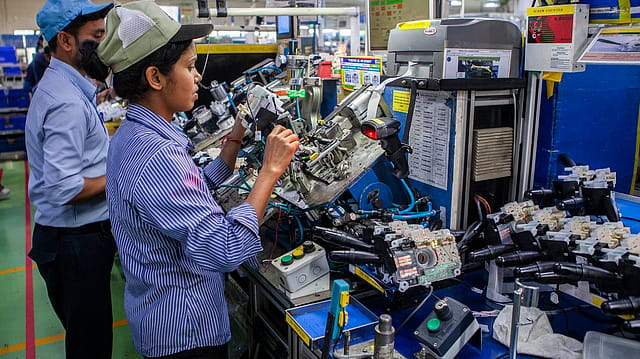India manufacturing PMI at 8-month high
ADVERTISEMENT

Indian manufacturing production rose at a sharp pace that was the fastest in eight months as new order intakes rose substantially in July, recovering the growth momentum lost in June.
The seasonally adjusted S&P Global India Manufacturing Purchasing Managers' Index (PMI) rose to 56.4 in July from 53.9 in June, highlighting the strongest improvement in the health of the sector for eight months.
A reading above 50 indicates an overall increase in output compared to the previous month.
Indian manufacturers made a positive start to the second fiscal quarter, with marked gains in growth of new business and output, the survey says.
While companies stepped up input purchasing, job creation remained marginal amid an uncertain outlook and a general lack of pressure on operating capacities, it says, adding that rates of both input cost and output charge inflation subsided.
The latest increase was in fact the most pronounced since last November, with quicker expansions recorded in all three broad areas of the manufacturing industry, says the suvey.
“The Indian manufacturing industry recorded a welcome combination of faster economic growth and softening inflation during July. Output expanded at the fastest pace since last November, a trend that was matched by the more forward-looking indicator new orders. Although the upturn in demand gained strength, there were clear signs that capacity pressures remained mild as backlogs rose only marginally and job creation remained subdued,” says Pollyanna De Lima, economics associate director at S&P Global Market Intelligence.
December 2025
The annual Fortune 500 India list, the definitive compendium of corporate performance, is out. This year, the cumulative revenue of the Fortune 500 India companies has breached $2 trillion for the first time. Plus, find out which are the Best B-schools in India.
Although international markets contributed to the latest upturn in total order books, there was a noticeably slowdown in external sales. New export orders rose at a moderate pace that was the weakest in the current four-month period of growth.
“Purchasing activity growth ticked higher in July and firms were successful in their efforts to obtain inputs amid a second consecutive improvement in supplier performance. This in turn supported a near-record increase in inventories of raw materials and semifinished goods as well as a softer upturn in input costs,” says Lima.
"With incidences of shortages diminishing, the rate of input cost inflation eased to an 11-month low in July, subsequently dragging down the rate of increase in output prices to the weakest in four months," Lima adds.
Inflation rates, for both input prices and output charges, were most acute in the capital goods segment. The weakest rises were noted in the intermediate goods sub-sector.
Despite the solid performance of the manufacturing industry, overall job creation remained subdued. The latest increase in employment was marginal and broadly similar to those seen in the current five-month sequence of growth. The vast majority of firms (98%) opted to leave workforce numbers unchanged amid a lack of pressure on operating capacity.
